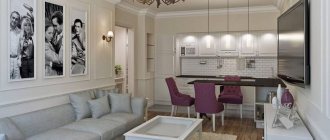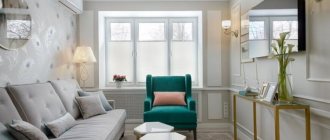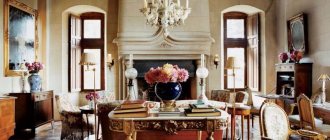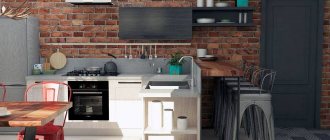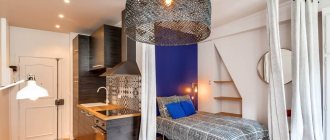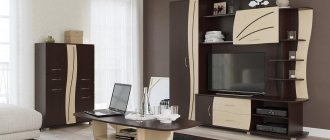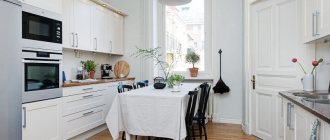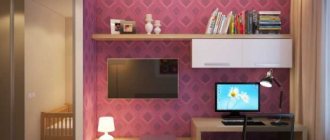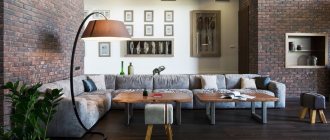All family members will pass through the passage room during the day. Therefore, it is important to organize everything in such a way that it suits all residents. The design of the passage room must be carefully thought out. It is worth taking into account all the shortcomings of the room in order to create an ideal and practical design.
The room should look holistic and harmonious. Don't forget about functionality. The entrance hall often serves as a living room, where guests are received and relax in the evenings. Sometimes this room also becomes a bedroom for some family members. Therefore, it is important to determine all the functions of the room and correctly combine them in one area.
The design of the passage room must be thought out to the smallest detail
The room should be designed in the same style
The walkway often serves as a living room, so it should be functional
Features of a living room with multiple exits
If the living room has several exits, standard interior ideas will not work. It is important to consider some nuances.
- How the doors will be installed.
- Floor quality.
- Organization of furniture arrangement.
- Territory zoning.
Having decided on each of the points, you will be able to properly and efficiently furnish the living room.
For a walk-through room with two exits, standard solutions are not suitable
If you plan everything correctly, you will end up with a functional and cozy room.
Stretch ceiling in a walk-through kitchen (video)
In a walk-through kitchen you can not only zone the area, but also create a unique, cozy image of the room. Taking into account the zoning methods and the rules for choosing furniture, a walk-through room can be in no way inferior to its isolated “colleagues”, or even surpass them. And if the kitchen is large, there are plenty of advantages in this layout.
The living room is undoubtedly the face of the house. This is where guests are received and family gatherings are held.
In order for everyone to feel at ease in this room, it is necessary to take the design of the room seriously. Especially if it is a walk-through living room.
Proper zoning of space
Zoning can add problems during registration. You will have to think through not only the places for convenient and comfortable arrangement of furniture so that nothing is cluttered, but also decide how to furnish each selected segment. The division must be carried out so that the areas do not differ greatly from each other. This will help maintain the overall idea of the interior. It is recommended to create only visual boundaries using color and lighting. Otherwise, there will be an additional obstacle to free movement around the apartment. Decide in advance what zones you want to create and where exactly they will be located.
Zoning of the room plays a very important role
The zones in the room should not be very different from each other
Think about zoning and furniture placement in advance
Selection of doors
When decorating the interior of a walk-through living room, it is recommended to give preference to sliding doors. They help save space, both in the living room and in the room next to it.
It is imperative to install doors between the kitchen and living room, as they will prevent foreign odors from entering the room for receiving guests.
Quite often, doors are installed between the children's room and the living room so as not to disturb the child's sleep while watching TV.
If the TV working in the living room does not interfere with the owners’ sleep, then installing a door between the bedroom and the living room can be abandoned. Installing doors between the living room and the corridor is also irrelevant.
Despite the fact that sliding doors are quite convenient and save space, it is not necessary to use them in a walk-through living room. It is quite possible to opt for single-leaf or double-leaf doors.
In order for the doors to isolate unnecessary noise, you need to pay special attention to the material for their manufacture. Doors with glass inserts do not retain noise well and transmit light, so installing them in the bedroom is impractical. But you can install it in the kitchen, since it is not afraid of moisture and is easy to clean.
It is best to opt for the following door materials:
- veneer;
- PVC;
- Tree.
In the latter case, you will have to spend a large sum of money, but the quality is worth it.
Options for opening openings
The location of the openings is of key importance in the proper design of the entrance. There are several options, each of which is described in the table.
| Location option | Description |
| Parallel | If the entrance to the room is located in this way, it is recommended to divide the room into several segments. In the area of the first section, place a TV, shelves and racks. It is important that objects allow free passage through the territory. If the TV is installed opposite a window opening, you should hang blackout curtains. Then there will be no glare. In the second area, arrange the necessary pieces of furniture. A sofa, a few armchairs and a small table are enough. |
| Diagonal | The location is inconvenient, reducing furniture arrangement options. The TV should be placed next to the wall where there is a door. A sofa, table and decorative elements are placed opposite. |
| Related | The best option. Only one corner turns out to be inconvenient, the rest of the space remains free for the implementation of various ideas. Place a TV on the wall with an opening, and place a set or several shelves nearby. Occupy the opposite space with furniture. |
| Openings on one wall | It all depends on the distance at which the doors are located. If there is enough space, it is worth placing a TV or fireplace there. The advantage of this option is the freedom of the rest of the room. This territory can be decorated as you wish. |
The location of the openings is of key importance in the proper design of the entrance
When planning your design, consider the location of doorways
Zoning the kitchen and living room
Almost all designer kitchens are combined, but combining them just to follow fashion is a bad idea.
To make a layout and arrange the furniture correctly, let's think about the pros and cons of a combined kitchen, what they come from and how to turn everything to your advantage:
- A large free space is perceived and looks better than several small ones. But for this, it should not be interrupted along the ceiling (as is the case with a door or arch).
- There is a place to relax and meet friends in an informal setting, where cooking is combined with the party, and does not precede it. The one who cooks is not cut off from the whole family. But for this, the person cooking in the kitchen should not have his back to the living room .
- Fewer walls mean more natural light. It is necessary to tear down all the walls that do not have a specific role.
- A small kitchen and a small living room with a lot of compromises in design turn into a small kitchen-living room where you can already turn around.
- Noise from some devices. Not scary, except for the refrigerator. They write about this in reviews, be sure to read it because... The noise level varies greatly among different manufacturers.
- The need for approval and costs for redevelopment. But you save on wall finishing and one interior door.
- Clean more often. The kitchen is always visible and dirt is carried around. We create closed storage areas.
- If your ventilation is not properly designed, odors will spread.
Stop, but what is this for?
Let's check how well the kitchen-living rooms below meet these requirements. 3 types:
Doesn't match at all:
Already good, but not the same:
Ideal layout of the kitchen-living room:
The design of a kitchen-living room begins with redevelopment, and it always pays off. If it is possible to improve the layout by moving walls, you should always do it - in most cases it costs up to $1000 to demolish old walls, build new ones and remove construction waste. For large cities this is less than the cost of one square meter.
If initially your rooms are not combined and you have to tear down the walls, then do not be afraid. Many people are afraid of redevelopment; they think that it is difficult and expensive. In fact, dismantling a non-permanent wall costs around $6 per square meter, about the same as erecting a new one. Demolition is accompanied by a lot of noise and construction debris, but this is also not a reason to refuse. The basic rule: if redevelopment provides any advantages, then it is always worth doing.
Don't be afraid to tear down and build walls - it's worth it.
Nuance:
They will never agree on a kitchen-living room for you if there is gas in the house. The only option is partitions, sliding doors, etc., or without approval. You decide. Examples below.
Partition
Since you are mentally ready to organize the ideal furniture arrangement, let's look at the options.
The design of a kitchen combined with a living room begins with thinking through the junction of these zones. Usually they are still separated in one of the following ways:
- Bar counter
- Island and peninsula
- Dining table for kitchen dining room living room
- Sofa with back to kitchen
- The partition is not the full height of the room
A kitchen with a bar counter combined with a living room is the gold standard, but I advise you to always make the counter wider if space allows. Then it can be used as a full-fledged dining table, and modern bar stools are no less comfortable than ordinary ones.
The island and peninsula are convenient, but the area must allow.
You can see many interesting and unusual options for kitchen-living room layouts in the material about the design of a studio apartment.
If you are lucky and have a large, friendly family that actually eats dinner together while talking, your option is a kitchen-dining-living room. If you eat separately in front of screens (which is normal), then even if the space allows, I would think twice about installing a regular dining table.
For a very small kitchen-living room where there is no room for partitions, a sofa with the back to the kitchen is a normal option.
It makes sense to use a permanent partition only if you clearly know why you need this partition and how it will be used (for example, for a TV). Otherwise, nothing prevents you from covering it with a tabletop and getting a bar counter, a bar table (if the tabletop is wider) or an island (if the height is the same as the work area and the sink or stove is removed).
Remember the scenarios from the previous paragraph and remember an important rule:
The sofa should not face the bar counter.
Finishing
What kind of flooring will you have in the kitchen area and living room area? If they are the same, then there are no questions. If there is a combination of laminate and tiles, where will their joint be? But laminate and tiles do not fit nicely and level. The joint should be made in the narrowest possible place and it should be level. Forget about curved joints. This is an ugly technical point that should be as invisible as possible.
The podium and height changes... they simply shouldn’t exist.
We will have 4 types of walls:
- The kitchen apron is the working wall between the lower and upper cabinets.
- If the sink is in a corner, then the adjacent wall is perpendicular.
- All walls that have countertops or tables adjacent to them.
- All other walls.
They differ in pollution load. The most dangerous is the corner wall near the sink. Everything is clear with aprons; they are made from the right materials. But for some reason they don’t think about the wall near the sink. In fact, water and dirt ALWAYS get on it. Therefore, we either go over it with an apron or cover it with decorative plaster (think in advance how to fit it in).
Other walls with adjacent countertops and tables are relatively safe, but once a year a stick shoots. In our case we are talking about spilling liquids (for example coffee). Skirting boards for countertops, washable materials for walls, or increased accuracy help out.
Upper kitchen cabinets should be up to the ceiling. Dot. To do this, you either need to initially choose the right kitchen, or lower the ceiling with plasterboard in the cabinet area.
Hood in a combined kitchen
It is important to consider ventilation in a combined kitchen. In standard mode, air enters the apartment through slightly open windows and other small cracks (infiltration). It comes out through the ventilation ducts in the bathrooms and kitchen. And this is where many people make a terrible mistake : they connect the hood to the kitchen ventilation duct without making a free exit.
Due to the filters in the hood and the bending of the corrugation, there is not enough pressure for the air to pass this way when the hood is turned off. As a result, the ventilation duct simply stops performing its function, and when the hood is turned off, odors spread throughout the apartment. This issue is resolved by installing a double or tee (depending on the relative location of the hood and the ventilation duct). The second one must have a check valve, otherwise, when the hood is turned on, the air may follow the path of least resistance, and instead of the ventilation duct, it will exit into the kitchen through the second hole.
If the kitchen is up to the ceiling, then the free outlet is led into a grate on the ceiling step above the cabinets. If there are no steps, the issue is resolved individually, such as a grille somewhere on the side or bottom of the facade.
Secrets of decorating a passage room
The key secret to designing such a space is the mandatory use of every centimeter. Follow these tips.
- Remember symmetry. If the doors are on the same wall, then fill the space between them. When openings in different parts of the room, add similar decorative elements to balance the overall look.
- Replace standard doors with sliding ones. This will free up space, visually make it larger, add airiness and lightness.
- Don't give up experimenting. You can move the opening by allocating a part for the passage corridor. Please coordinate such actions with the relevant authorities in advance.
- Connect the corridor and the living room. This will expand the space.
Every centimeter of the room is important
A room in dark colors will create a feeling of warmth and comfort.
Sliding doors will be an excellent replacement for conventional ones
Design rules for a walk-through living room
It is recommended to play up the open nature of the passage room. It is worth letting in maximum light, more air and glass surfaces. Non-load-bearing walls can be replaced with glass partitions, which will make the atmosphere spacious, airy and light.
Don't abuse zoning. Create separate segments only when necessary. If the living room fulfills its functions, and others are not assigned to it, then there is no point in creating even visual boundaries.
The classic furniture arrangement scheme is not suitable for the entrance area. The main thing is that it is convenient to move around all rooms.
There should be enough light in the room
Glass surfaces will look very beautiful
The best photos of kitchen-living room design
Let's start right away with the most stylish examples:
Have you noticed that this is a single space without artificial division?
Firstly, the entire kitchen-living room is designed in the same style and color scheme. There is no “visual zoning” and there shouldn’t be. The color scheme is neutral, because... color combinations in an open space are more difficult and there is a risk when using bright colors.
Secondly, all but 1 kitchen is to the ceiling, they have a lot of closed storage areas, and the style is modern and with a touch of minimalism. Clutter and excess trash in the kitchen combined with the living room instantly destroys the entire design.
A photo of two mistakes at once : the kitchen is not up to the ceiling and there is trash accumulated there, there is a step on the ceiling where it is not needed. If they had lowered the ceiling in the closet area, it would have been a different matter.
But the lighting should be separate and it is important to think through the switches in detail in advance. And yes, the interior of the kitchen-living room critically depends on proper light.
We count the contours of light:
- Separate main overhead light in the kitchen and living room areas.
- General decorative lighting including all hidden background light and apron lighting , LED strips under the bar counter.
- Light above the dining area and, because... It is usually in the center of the room; it is better to choose stylish, catchy designer lamps.
- Floor lamp near the sofa.
It's minimum. The LED strip under the arrow should be turned on from the same switch as the apron.
About the first 2 points:
Bright overhead light is usually used only during cooking or cleaning; the rest of the time, functional and background light is used. Hanging an overhead light on 1 switch directly above the kitchen and living room is a mistake because... it is almost never needed there at the same time.
But background light is needed everywhere at once and it should be on 1 button located at the entrance to the room (can be duplicated with a pass-through switch near the sofa).
And as they usually do: the kitchen workers make the lighting under the upper cabinets and turn it on with a button there, the rest is installed by the finishers and is also turned on locally. But you don’t want to be in the kitchen area when the living room is completely dark, and vice versa. Run from one end of the room to the other 2 times to turn it on and off too. That's why:
Don’t even think about switching on the LED strips on the apron itself. Place the switch where everyone else does - at the entrance to the kitchen.
This is all laid out at the very beginning of the renovation when installing electrical wiring, so in the material about the kitchen project I wrote that design is not only about furniture, and which part should be done independently.
Design of a passage room in a Khrushchev building
The advantage of the entrance in Khrushchev is the window, which occupies most of the wall. Complete the window opening with light, almost transparent curtains, which will softly diffuse the light. Opposite it is worth placing a partition with a mirror or glossy surface. To expand the space, you can connect the living room and kitchen. Do not use bulky furniture, it will visually “eat up” the space. Pay attention to compact, multifunctional options. Large chandeliers are not suitable for the room. Replace them with floor lamps and sconces.
Sliding systems will help save some space
The living room can be combined with the kitchen
Light shades will visually expand the boundaries of the room
Effective camouflage of doors
Masking is required to create a cohesive look for the interior. One method is to decorate with pieces of furniture. You can paint on the walls, smoothly transitioning to the doors. The method is suitable only if it fits into the overall style. It will look as if the door becomes an extension of the wall. Painting adds liveliness and originality to the design.
Light colors will visually increase the size of the room
Painting on the wall will perfectly complement the interior of the room
Decorating the walls and floor of the room
To decorate the walls, you can use photo wallpaper, which allows you to visually make the boundaries of the space wider. You can always place the paintings in a V shape. Large patterns visually reduce the space. Therefore, they should not be on curtains or finishing materials. Plain coatings or with small patterns allow you to add freedom.
To increase space, you should carefully consider the option of laying folk coverings. Laminate or parquet should be placed diagonally and not along the walls. Choose mainly light-colored materials.
There should be enough light in the passage room
The walls in the room can be covered with wallpaper
The paintings will fit perfectly into the overall interior of the room.
Color scheme and lighting
It is recommended to use light shades. They allow you to visually expand the territory, adding freedom and air to the room. It is better to choose plain coatings, without patterns or large ornaments. If you want to add a little dark color, then choose only one wall for it.
The color should be chosen based on the functions that the room will perform.
It is not recommended to use many dark shades
There should be a lot of light in the entrance area, both natural and artificial. Therefore, do not use thick curtains for the window; it is better to use lightweight transparent materials. Add more light sources. A large chandelier will not work, so use sconces. An excellent solution would be spotlights with different directions.
Interior of a walk-through living room: does the room have any advantages?
Contrary to appearances, adjoining rooms are not necessarily problematic in terms of design. This can be quite a useful part of the apartment. As the name suggests, the adjoining living room has other rooms running through it, such as the bedroom, kitchen or bathroom. Thanks to this, you can separate the night zone from the day zone or the recreation area from the work area.
Depending on the location and function of the walk-through living room, you can get:
- more peace of mind;
- convenient place to work;
- plenty of storage space;
- the best conditions for receiving guests, since the adjacent room serves as a living room;
- increased property value because adjoining rooms can give the apartment a more designer or even prestigious look.
As you can see, there can be many benefits to a walk-through living room, so be sure to consider them before knocking down walls and expanding the room with “unnecessary” housing, if at all possible. Of course, mastering such a space is not easy, but below you will find some tips on how to arrange a walk-through living room in such a way as to get the most out of it.
